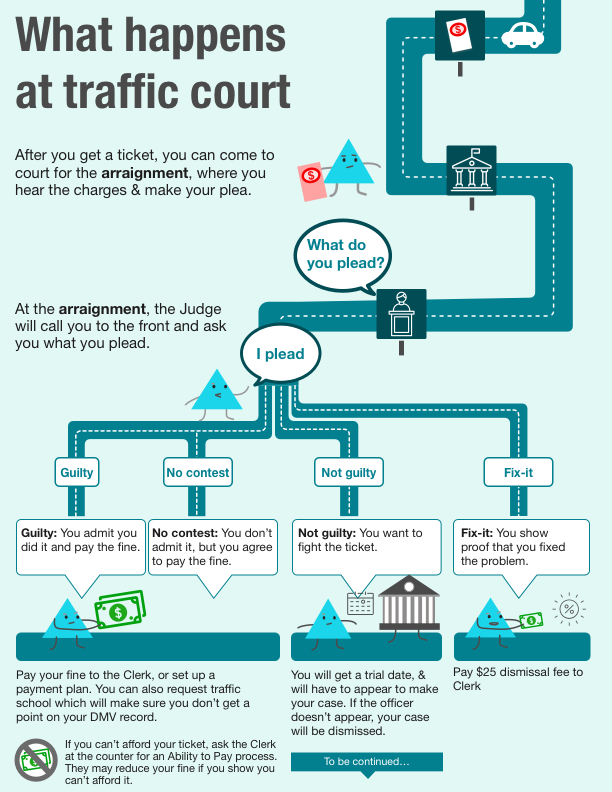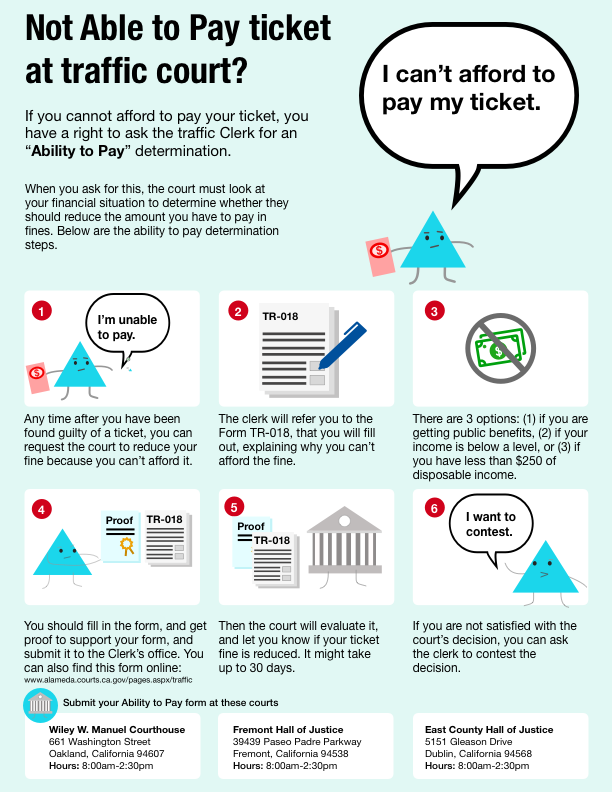This is a report from the ongoing Traffic Court redesign project.
You can read the first report of our design observations and theme synthesis here, and then the results of community testing of prototypes here.
:::
This Spring the Legal Design Lab’ ran the Design for Justice class, all about how traffic courts in Alameda County county could be made more user-friendly — and, more deeply, how traffic citation fines, fees, and punishments could be less destructive for people who have been ticketed.
Traffic court itself is pretty miserable — almost anyone who’s been through it can tell you how slow, boring, and opaque it is. But the process of being ticketed, having to show up to court, having to figure out your plea options, and wrestling with a huge set of fines is also possibly very damaging. As documented elsewhere, traffic fines and fees can have huge financial impact on people — especially if they miss a date or a payment, and the costs start to skyrocket.
So, our class decided to tackle traffic citations as a system challenge. What should courts, legal aid groups, and other actors be investing in, to prevent these court fines from exacerbating racial and social inequality? And, can a better user experience and service design improve people’s ability to navigate this burdensome system, make strategic decisions, and avoid life-ruining consequences?
Our class took a systems-design approach, combined with design thinking, to this challenge. We did user interviews and observations with stakeholders on both sides of the court system (users and professionals). We mapped out personas across the system, listed out design requirements, and noted where on the system map there was already energy for change and new movements. Then we went into rough prototyping and testing — and that’s where we’re at now. Read more about our class in detail, we wrote another Medium piece about it.
From our two intensive sprints in the spring, we generated a pared-down list of refined concepts that could make the traffic system more fair, and the fines and fees of traffic citations less harmful.
So, what were the most promising concepts that emerged out of our workshops and co-design?
1. Traffic Ticket Power Search
Can we create a single federated search of all the counties’ traffic ticket databases (plus all states)? And ideally, also include the status of outstanding traffic ticket debt held by private collection agencies, and the DMV? These agencies’ info should all be linked together, and accessible to a person.

Currently, it’s hard to find what tickets a person has, or how much debt they owe. This is because each county traffic system has a different site where traffic ticket information is stored, if they have a site at all. When they send outstanding fines and fees to a private debt collection agency, it becomes even more difficult to get transparent information about tickets. A person can’t find the amount they owe online, and if they call, they are often given the run around and not given clear and reliable information.

What if there was one site where a person (or their advocate) could search for where they stand on traffic tickets? This would show them the tickets they owe, the status and actions available to them, and exactly how much money they owe (and how to pay it off clearly).
2. Visual Guides to Traffic Court System
The people we met struggled to understand how the system works, and how to act strategically. This is particularly true regarding the new option in California, to get an “Ability to Pay” reduction of your ticket fine based on your financial hardship. It’s very hard to know that this option is available — and even if you do hear about it, it’s not clear exactly how you can claim it.

We propose to make visual signs, handouts, maps, and other guides that show very clearly how to navigate the system. Above, see one of our posters and/or fliers for distribution in the court, to make the basic process of the traffic court arraignment clear.
Below, we have a similar walkthrough for getting an Ability to Pay reduction.

These visual guides can go at various intervention and trigger moments. They can be posted up on the walls of the court building, wherever people are waiting in lines or in ‘down-moments’. They can be distributed in the lines outside of the courthouse or in a traffic court’s waiting area as a brochure or handout.
They can be on the court’s website, and even (in a smaller version) on the actual citation. And they can be posted on social media. The goal here is to blanket the possible forms with this visual outreach, to get it any way and every way to people who will be coming to traffic court.
3. Interactive, Digital “Ability to Pay” reduction tool
As California (and other states) roll out a new court rule to let people ask for a reduction in fines based on their financial situation, the question is: How to implement this in the best way?
The first way (the default of most courts) being tried is to publish a paper-based form for people to fill in.

If a person want to reduce their fines, they must fill in a one or two page form, that says why they can’t afford their ticket, answer questions about their income and household, and provide evidence. This will then be submitted in person to a clerk at the county court. The clerk will get it to the financial officer, to evaluate the claims and the evidence, and make a decision about whether to reduce the fine. It’s all in paperwork, takes many hand-offs, and it takes an unknown amount of time.
We propose a better way: an interactive digital application, that could be hosted on the court’s website.

If we have a digital, online tool, we can present the person with only the most relevant questions, have them answer right there, and then gather their evidence with photos or attachments.
This can then be submitted to the financial officer, from the app to the officer’s court email. An automated reply can then be sent to the person, via SMS or via email, that their application has been received and is being processed, with an expected timeline to follow.

This will save time and money in completing the form and filing it in person. It should also improve the accuracy of the application, by providing more instant support and examples. And most of all, it should give a feeling of control to the user. Ideally, they’ll have better oversight of what to expect and what’s going on.
4. Automatic Letter Negotiation
Our fourth idea is about translating the benefits of in-peson appearances at court, with the convenience of asynchronous, written process.
Right now, if you want to negotiate or reduce your ticket fine, you must appear in person before the judge. Or (though most people aren’t aware of it) you can write a snail-mail letter to the court, explaining your plea and your situation. You cannot negotiate online — you can only pay off your ticket in full on the court’s website. If you want any reduction, or if you want to contest the ticket, you must appear physically in court — which is a lengthy, intimidating process.
Our idea is to use the under-utilized letter-writing opportunity. If the judges accept letter-based pleas, requests, and negotiations, then we can help make this process easier. Ideally, we can create a tool that lets people enter in their basic information, and their side of the story. Then our tool generates a letter to be reviewed and sent to the court. It can make an official presentation of the person’s story and their request for a reduction.
The tool could also mail this letter for the person — and manage future correspondence with the court. Or the tool could generate the letter for the person, and let them print it, mail it, and manage the correspondence from there.
It would have to be run by a body independent of the courts, potentially an advocacy organization, a clinic, or a law school. The goal would be to package this advocacy into an automated tool, and make it easy, affordable, and convenient to get a deal without showing up at court.
5. On Track Mobile Reminders
Our final big idea is to equip the user with insights and coaching into the process, through regular tech-based messaging.
For people with tickets, one of the worst things to do — but also most common thing to do — is to miss deadlines. This could be missing the window to be arraigned for your ticket (make a plea). Or once you’ve made plea, then you have to meet your payment deadlines, and your future court dates. If you miss payments or court hearings, then “civil assessment” fees get added to your original fines, and your driver’s license can be taken away from you. Missing dates has major financial and life consequences.

We propose the court provide users with SMS-based reminders for hearing and payment deadlines. This will ensure the person is aware of when they need to take care of the deadlines, so hopefully ether will be able to deal with it before it spirals into huge penalties.
The court (or a third party group) can get the person enrolled for text messages at the time of ticket, or at the time of signing up for the service. With the user’s phone number and deadline’s event date, then the service can send automated reminders and warnings.
So, to the future…
We are midway through our design process. This upcoming quarter at Stanford d.school, we will be running another intensive sprint to test these and other ideas with users, court staff, policy-makers, and other stakeholders. Which ones will they rank the highest? How will they propose to change, improve, or deepen the impact of these five ideas?
As we gather more testing feedback, we’ll report back on the final recommendations (if not also some pilots in the works). We have visual maps already in use in Alameda County, and we want to build from that momentum.
Our other horizon is linking these product and service prototypes to larger policy and rule changes. There is major energy for change in California and elsewhere, with the recognition that traffic fines and fees exacerbate poverty and inequality. What should new court rules, statewide laws, or other policies be, to solve this problem at a more fundamental level?
